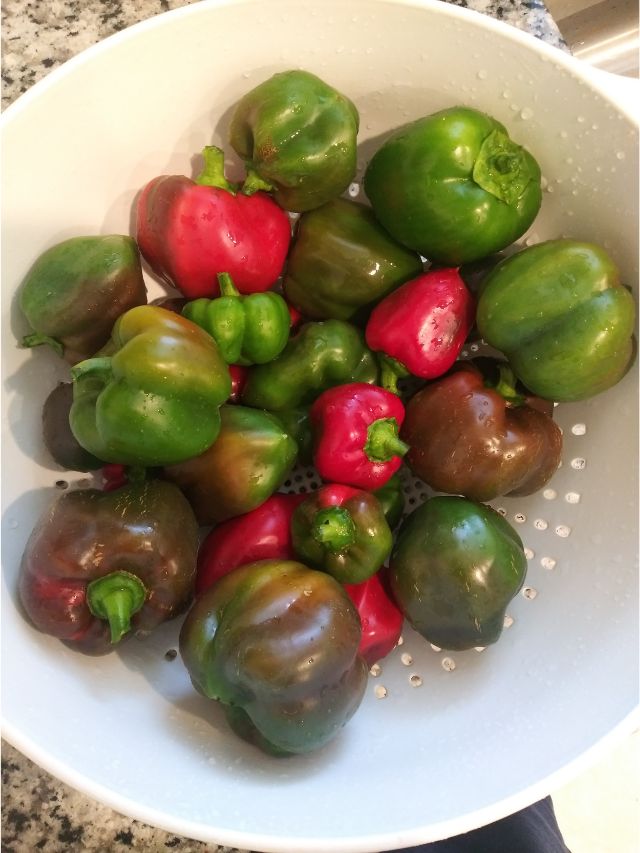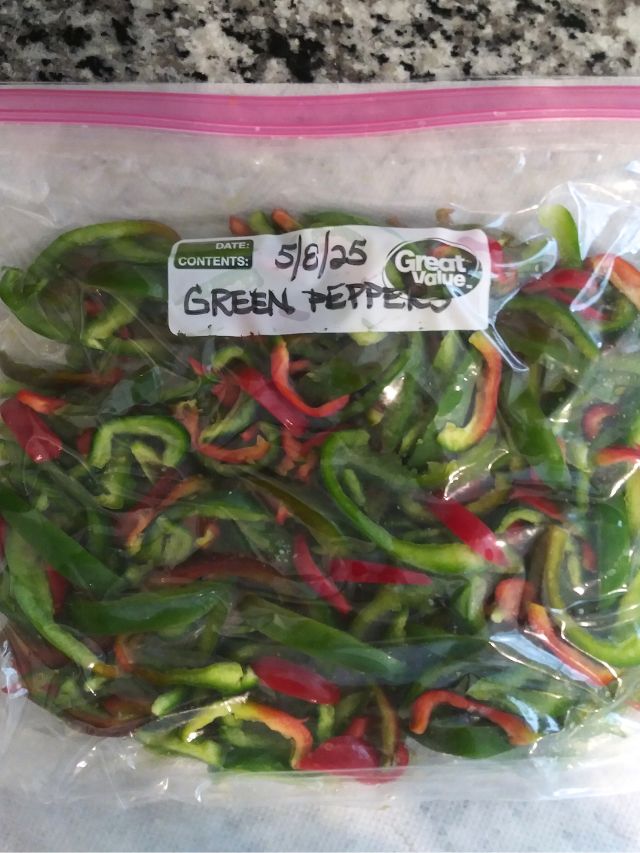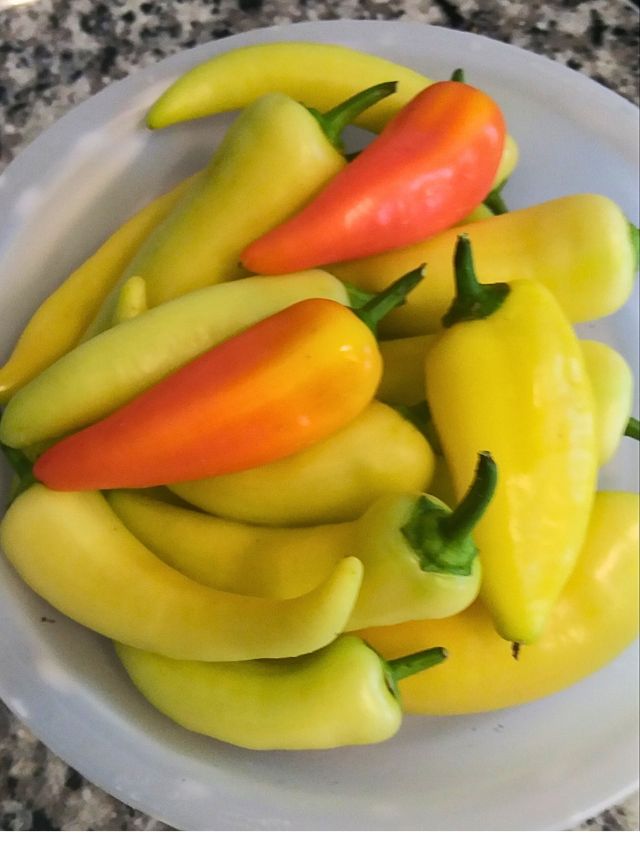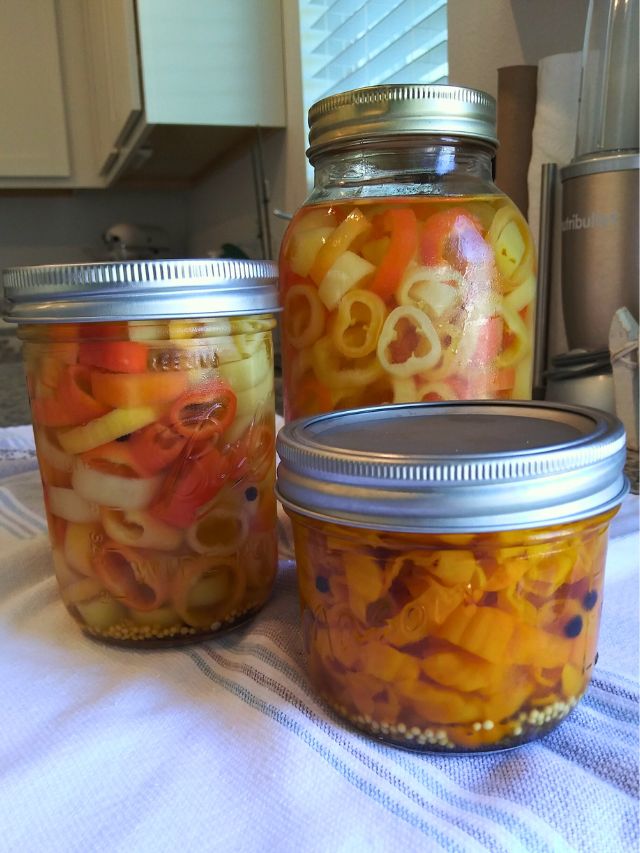How To Use Up A Lot Of Bell Peppers
Our plants have been producing an abundance of bell peppers. We’ve had to get a little creative about how to use them all.

Actually, it’s not just bell peppers. We’ve also been harvesting a bounty of banana peppers and a habanero-type pepper called the Numex Suave.
Here in Central Florida Zone 9B, pepper plants can be grown as a perennial, meaning we don’t have to start new plants every season. As long as we keep them fertilized and protect them from cold snaps, they will just keep on growing and producing more peppers. And more peppers, and more peppers…
It should be a good problem to have, right? We love to use peppers in our cooking. We also eat them raw in salads or for dipping into things like hummus and veggie dips. And pickled banana or Numex peppers are delicious in a number of ways – even straight out of the jar.
But it’s come to the point where I’m thinking, “Maybe we should stop fertilizing these darn pepper plants!” I mean, don’t they ever have a dormant stage? And is it possible to get too much Vitamin C?
Here’s a fun fact: standard green (or “bell”) peppers contain more Vitamin C than oranges. In fact, the red ones have nearly three times as much.
In addition, peppers provide other essential nutrients, improve eye health, and reduce inflammation, just for starters. It seems they are really good for you in lots of ways. You can read more about some of their many benefits here.
At least they aren’t keeping us awake at night. According to this article on their history, bell peppers originally had an elongated stigma inside that acted like a natural clapper, causing them to make a noise when they were shaken or blown about by the wind. Hence the name “bell” pepper. I always thought they were called bell peppers because of their shape, so this was a surprise to me. (We can thank plant breeder Gregor Carillon for developing the first silent bell peppers in 1908.)
So what to do with all these peppers…
Of course, we’ve been racking our brains to think of ways to cook with them. We’ve compiled quite a long list of recipes that use the bell peppers we grow, like:
- Stuffed peppers
- Greek salad (with red and green peppers)
- Pasta salad
- Philly cheesesteak sandwiches
- Fajitas
- Pizza topped with peppers, onions, and mushrooms
- Stir-fry
- Sheet pan dinners with roasted peppers
- Pepper steak
- Hawaiian meatballs with pineapple and green peppers
- Grilled kebobs with pepper chunks
- Asian lettuce wraps
- Chili
- And so on, and so on… Maybe I’ll do another post on more of these recipes later 🙂
We’ve also been freezing bell peppers. I’m hoping one day the plants will stop producing so many and there will be a need for the ones in the freezer.

Freezing the peppers is a really simple process. And it’s handy to have them cut up and ready to use.
All you need to do is wash the whole peppers and let them dry. Then you’ll want to remove the ribs and seeds. I cut mine into fairly thin slices, but you can also chop them up as you would for chili or spaghetti sauce. And that’s it! You can lay them out on a sheet pan to freeze before putting them into bags, but I find that’s not really necessary. I just load them into freezer bags, try to remove as much of the air as possible when I seal them, and throw them in the freezer. They’ll stay good for six to twelve months, but hopefully ours won’t last that long.
To preserve the banana and Numex Suave peppers, we’ve been quick pickling a lot of them. We usually prefer to eat these types of peppers pickled.

I haven’t ventured into the canning world as a long-term food preservation method yet. That’s something I plan to do eventually. But for now, the quick pickling process has been a fun and tasty way to preserve some of what we’re growing, like the peppers.
It’s also an easy method I can use for a relatively small amount of produce. Start by washing the peppers and cutting off the stem ends. You can use a chopstick to remove the seeds from the peppers. Just run it around inside the pepper to loosen the seeds and then shake them out. Cut the seeded peppers into 1/4″ slices.
For two cups of sliced peppers (about 6-8 banana peppers), I use a 16 ounce mason jar. In a small pan, bring 1 cup of water, 1/2 cup of white vinegar, 1/2 tablespoon of salt, and 1 teaspoon of sugar to a boil. Remove the pan from the heat and add the spices. I use about 1/2 teaspoon mustard seed, 1/2 teaspoon black peppercorns, 1/4 teaspoon celery seed, and a small clove of garlic, peeled. You can adjust those to your taste or add your own blend. Pour the pickling liquid into the jar, making sure all the peppers are covered. Screw on the lid, and leave on the counter until it is cooled before refrigerating.
If I have more peppers and want to fill a quart-sized mason jar, I double the recipe for the pickling liquid. These are ready to eat in a few hours, but the flavors improve if you wait a couple of days.

If you find yourself with an overabundance of peppers and you’ve tried eating a lot, freezing some, and pickling a few jars full, and you still have more than you need, you can always give some away.
I haven’t found anyone who will turn down a gift of freshly-picked, homegrown produce. Unless they just don’t care for peppers 🙂
